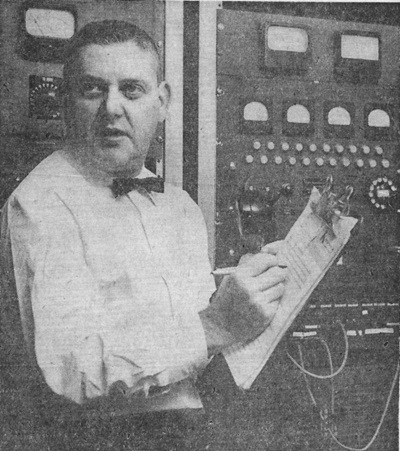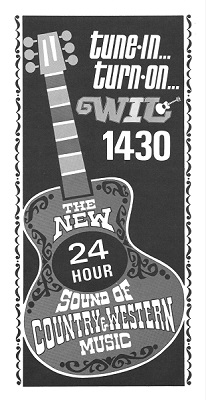Ed Goodberlet, studio control operator, was called into the manager’s office one day in 1926. There he found all the other KMOX engineers lined up before the desk of Thomas P. Convey.
Convey started abruptly: “I’ve been informed that you men have joined a labor union…What’s the matter with you? Aren’t you satisfied with what you’re getting here? Do you expect a union to do any better for you?”
His voice grew sharp as he pulled out a slip of paper.
“Now here is a statement I want you men to sign, saying that you’ll not have anything more to do with this union and that you’re satisfied to work at the prevailing wages.”
He handed the statement to Goodberlet first.
Goodberlet refused to sign, and he was immediately fired.
Convey then handed the paper to Erle White, another control operator. White, too, turned it down. He, too, was fired.
The other engineers looked coldly at Convey, and no one stepped forward to sign.
Convey waved them back to work and with a flushed face returned to his desk.
Shortly afterward, Bill Ludgate, chairman of the radio division of Local 1 of St. Louis, the cornerstone local of the Brotherhood, went to the KMOX office at the Mayfair Hotel to discuss the two firings with Convey. The station manager met him at the door, and in a torrent of profanity Convey said that no blankety-blank union was going to tell him who he’d hire or fire.
“I’ll hire or fire whom I please,” he said.
When Ludgate asked why the two men were fired, Convey replied, “I just didn’t like their looks.”
“Looks have no bearing whatever on the matter, Mr. Convey,” said Ludgate. “This is a matter we should be able to settle amicably. Meanwhile these men must be returned to their jobs…or we will be compelled to pull all your other operators off the job until the matter is settled. Either return these men to their jobs by five o’clock this afternoon, or we’ll take strike action.”
Five o’clock came, and Goodberlet and White were still out. The switches were pulled at the studios and transmitter, and on instructions from Business Agent Arthur Schading, the men began to picket.
Thus began what labor history has recorded as the first strike by organized labor at any radio station in the United States. This was a time when the nation was rising toward its first big financial boom. Radio stations were mushrooming across the country, as the Department of Commerce transferred its communications control work to the new Federal Radio Commission.
Ed Goodberlet, the first man fired, was working for $30 a week, on duty for 48 hours. An engineer performed every job at a radio station from emptying the wastebaskets to occasionally announcing Caruso records.
KMOX, “The Voice of St. Louis, Missouri,” had gone on the air on Christmas Eve, 1925. It was a pioneer station of the Midwest. Supported strongly by the St. Louis Globe-Democrat newspaper, the station had 15 financial backers – all prominent businessmen of the community. The site for the transmitter was donated by the Kirkwood Trust Company. Leading light of the establishment was Thomas P. Convey, a man described by Bill Ludgate as a “promoter of the bombastic type who literally wore his likes and dislikes on his coat sleeve.”
Convey came from Chicago to promote the St. Louis Radio Show at the Coliseum. He had been invited to St. Louis by William Mackle, secretary of the St. Louis Radio Trade Association. Seeing possibilities in the city, Convey persuaded local firms to underwrite a new broadcasting station. He had approached the St. Louis Post-Dispatch, owner and operator of Station KSD, without success. In time, he acquired enough capital and began his operation.
He didn’t forget the cold shoulder of the Post-Dispatch, however. Bill Ludgate, an engineer at KSD at the time, tells of witnessing the opening of a floral box sent to the city desk of the newspaper by Convey on the day KMOX began broadcasting.
The box was more than three feet long, a foot wide, and half a foot deep. Inside the box was a large bouquet of vegetables tied with a ribbon made of toilet paper. There were onions, carrots, beets, spinach, celery, and lemons. Accompanying the box was an embossed card with the inscription, “Compliments of Thomas Patrick Convey, General Manager, Radio Station KMOX.”
A little more than four months later, Convey’s actions had precipitated a strike at the new station.
A day after the men walked out, Convey called Ludgate and in subdued tones said that he had thought matters over and, since the Board of Directors of KMOX was meeting that night, he suggested that the union put its demands in writing so that he could present them to the board.
Schading, Ludgate, and other leaders of Local No. 1’s radio group put their demands on paper. They were simply this: The station must grant official recognition to the union.
These demands were delivered by special messenger to Convey at the Mayfair Hotel, who, upon reading them, dropped them back into the envelope, placed his name and address on the outside, pasted on a postage stamp, and dropped the sealed envelope into a mail box, knowing that the envelope would not be delivered to him until the next morning.
The union had anticipated such a move. A duplicate copy of the demands was sent to a member of the board who was on good terms with Local No. 1. (Of the 15 corporations represented on the board, no less than 11 had union contracts.)
Meanwhile, Convey telephoned Western Electric Company in New Jersey for the services of an engineer to help put the station back on the air. Tom McLean, KMOX chief engineer, met the WE man at the airport, assured him that there was nothing wrong with the equipment and urged him to leave it alone. The station remained off the air.
At the KMOX board meeting Convey was asked if he had received the union’s demands.
“I’ve had no word whatsoever from the union,” was his intense reply.
“That’s strange,” interjected a board member. “I have a copy of the demands that Mr. Arthur Schading, business agent for Local 1 of the IBEW, delivered to you by messenger only this afternoon.”
Convey’s methods were exposed, and the meeting adjourned on a sour note until the next afternoon, so that BA (Business Agent) Schading could appear and present the union demands in person.
The strike was settled and on the union’s terms. A new salary schedule was established, calling for $45 a week for studio operators and $55 a week for transmitter operators. The board of directors requested that a salary increase be held up temporarily to give the station owners time to increase their budget for 1926.
A short time later the KMOX board terminated its two-year contract with Convey, paying him in full. The deposed station manager went to Florida, but within the year he was back in St. Louis, where he made a down payment on another station, purchasing KFVE from Benson interests. He obtained the attic space in the Chase Hotel and went on the air with new call letters – KWK.
There he made his fortune…and with union operators all the way.
Nevertheless, he literally died fighting the unions, Local 1 historians report. In the early 1930s his appendix burst at a contract meeting between St. Louis stations and the late H. P. Koenig, Local 1 business agent.
(Originally published in IBEW Technician – Engineer 12/1958)
 I scraped up the money for the down payment and applied to the FCC for a license to operate a station at Jefferson and Olive. It was my intention at that time to put a small tower on the building there. I got the license and the list of available call letters. I liked the sound of KCFM and chose that one. Since then I’ve had reason to wonder why. People keep thinking it’s a Kansas City station.
I scraped up the money for the down payment and applied to the FCC for a license to operate a station at Jefferson and Olive. It was my intention at that time to put a small tower on the building there. I got the license and the list of available call letters. I liked the sound of KCFM and chose that one. Since then I’ve had reason to wonder why. People keep thinking it’s a Kansas City station. The first was Davie Lee from Dallas who was also named as music director. That meant he was responsible for all the music to be played on the station. For about a year, Davie did the overnight show before moving to the 10 to 2 slot for the next 20 years. Next was Dick Byrd from San Diego, the morning man from 5 to 9 AM. Chris did the 9 to 11 AM slot.
The first was Davie Lee from Dallas who was also named as music director. That meant he was responsible for all the music to be played on the station. For about a year, Davie did the overnight show before moving to the 10 to 2 slot for the next 20 years. Next was Dick Byrd from San Diego, the morning man from 5 to 9 AM. Chris did the 9 to 11 AM slot.